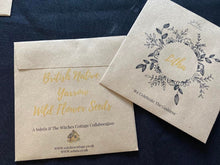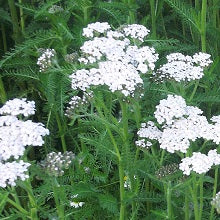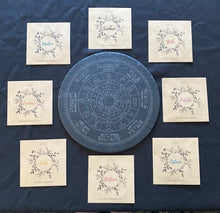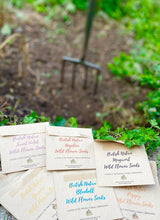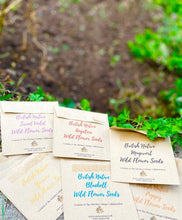
Wheel of the year wildflower seeds
Litha seed packet - native wildflower Yarrow seeds
Certain plants have always been extremely valuable to us. We know one of them as yarrow. This plant became a powerful ally for us here on Earth a long time ago, as was clearly revealed by its presence in Neanderthal graves discovered in the Mediterranean basin, reportedly dating back around 60,000 years!
Yarrow is steeped in myth and legend; it is a plant that many cultures of the world have widely used and revered. Achillea millefolium was named in honour of the Greek god Achilles; who according to legend, had course to widely employ this wound staunching herb on the battlefield.
Undoubtedly a sovereign remedy of our herbal medicine cabinet as you will soon see, yarrow rightly remains a favourite of practitioners working with plant medicines. Alongside dandelions and plantains, yarrow is another of our globally available, herbal first aid plants!

Description
Wispy, feathery foliage, which superficially resembles the wild carrot. Yarrow’s laciniate leaves, with their thin and finely divided lobes, gave rise to its other common names; ‘milfoil’ and ‘thousand leaf’.
New growth will re-emerge from its creeping and steadily spreading rhizomes in early spring. This root system means we regularly find the plant growing as dense mats. The basal leaves are sometimes quite large and sprawling, always on long petioles, and initially grow in a rosette. When coming into flower, the stem leaves become shorter, sessile, and alternately spaced.
Yarrow blooms from June, with furrowed, flowering stems, typically reaching heights of 60-70cm. Often referred to as ‘umbel-like’; the untrained eye could initially mistake yarrow’s flowering structure for an umbel, and place yarrow in the carrot family.
However, look closely from below, and you will observe numerous flower stalks condensed together high up the stem, and you will see how they do not all originate from a central point on the stem, as per umbelliferous plants.
The composite flowers taste bitter, and have a characteristic medicinal odour. Usually, yarrow has creamy white ray-florets, delicately framing the orange-tinted, central disk-florets. But pink strains of yarrow will frequently be seen. Five or six florets are typically found in each individual flower head.
Habitat
Yarrow grows in a range of habitats, throughout Britain and Ireland, except for areas which are permanently waterlogged, or on soils that are strongly acidic (pH < 5.5).
It happily colonises waysides, pastures, grassy places, hedgerows, and waste-ground, in town or country, throughout the land. A lover of temperate climates, you can almost always easily find yarrow in Britain, even at altitudes of up to around 1100 metres. On the coast, look in fields by the dunes and stabilised shingle.
Yarrow thrives in harsh conditions without losing a fresh look of vitality. This becomes especially noticeable during droughts, when its dark green foliage stands out from brown and withered neighbouring plants.
Parts used: Leaves / flowering tops.
Harvest
Leaves: Spring – when young.
Flowers: From July – September, just when opening.
Key medicinal constituents
Volatile oil (including cineol, eugenol, thujone, camphor, azulene); bitter principles; tannins; salicylic acid, isovalerianic acid.
Actions: Anti-inflammatory, anti-septic, diuretic, diaphoretic, astringent, expectorant, vulnerary.
Pharmacology and uses: As an edible, yarrow will be embraced in the kitchen of the adventurous, and by folk looking for foods that double as preventative medicines.
During spring and early summer, the younger leaves give a lovely, crunchy texture in a mixed salad, while offering slightly bitter, yet subtle and savoury medicinal tones. A strong and intoxicating beer can reportedly be made with yarrow from a number of recipes!
As medicine, yarrow has chiefly been used as a wound herb. The tannins exhibit an astringent effect, on both exterior and interior surfaces of the body.
The volatile oil constituents, such as cineole, have antiseptic qualities, while azulene, responsible for the blue colour of the essential oil, not only reduces inflammation, but stimulates the formulation of tissue for wound healing.
Couple this with the general astringency, and yarrow can swiftly, and effectively, help seal and heal all manner of cuts and wounds!
Regularly eating or drinking yarrow helps prevent and treat dyspepsia and ulceration – two conditions that alcohol or caffeine, coupled with a rich diet, can help manifest.
Yarrow promotes a sedative activity on the nervous system, and is often employed as an anti-spasmodic for nervous dyspepsia. Yarrow is acclaimed for helping heal and tone the mucus membranes throughout the gastro-intestinal-tract.
Nature’s abundant anti-inflammatory phenol, salicylic acid (aka salicin), can be found in yarrow, just as with meadowsweet (Filipendula sp.) or willow (Salix sp.). Try yarrow where you can’t find chamomile.
As a diaphoretic, yarrow will regularly be used for fevers, and also helps with palpitations, painful menstrual periods, and convulsions; as well as being of use as a peripheral vasodilator, diuretic, and mild expectorant.
As with any member of the Asteracea family, there comes slight risk of possible sensitivity for some individuals, especially those with dermatological problems. As ever, always seek professional advice before using wild plants as medicines.





